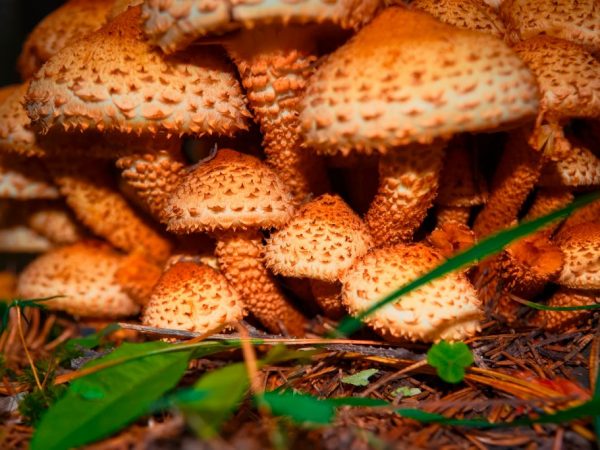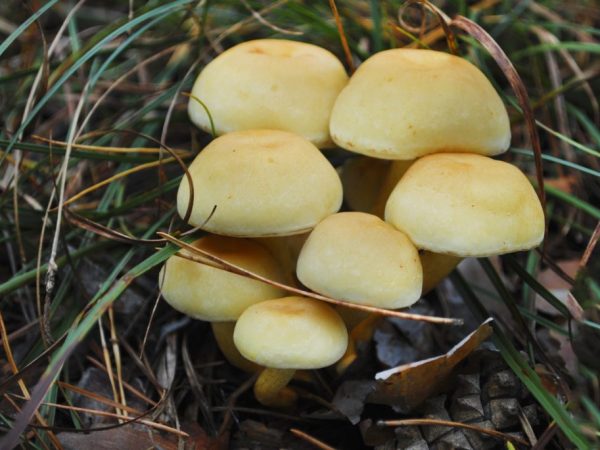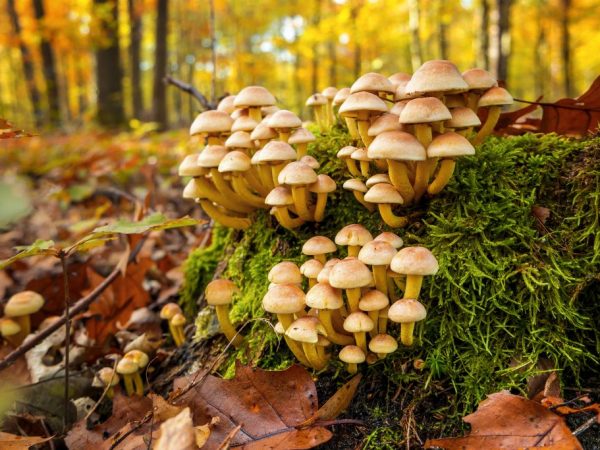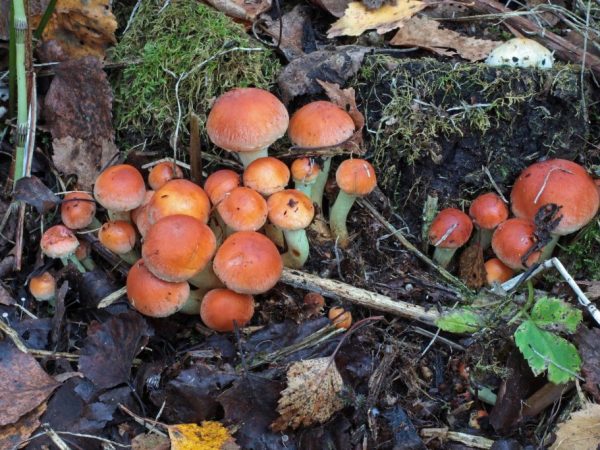How to distinguish false mushrooms
Honey mushrooms belong to the group of hard-to-recognize mushrooms. They include many varieties belonging to different families. Among them there are edible and inedible species. It is difficult to distinguish false mushrooms, because each false honey in appearance, size and habitat resembles a real mushroom.

Differences between false agarics and real ones
Views
Honey mushrooms are divided into several types: winter, spring, summer and autumn. Each has its own false views.
Winter mushrooms
The type of winter mushroom or flammulina velvety-footed, differs from other varieties in the time of harvest. It occurs in mid-autumn and can continue throughout the winter.
Winter mushrooms (flammulina) grow on stumps of birches and oaks. They have a hemispherical, honey-yellow float. In conditions of high humidity, its surface becomes mucous.
The pulp is creamy in color. There are no scales and rings on the leg.
This type is tasty and valuable among honey mushroom lovers, although not everyone likes that during cooking they become slimy. In addition, this species is suitable for cultivation at home.
Winter mushrooms grown at home are not inferior in taste to their forest counterparts and at the same time are absolutely safe.
Spring mushrooms
One of the most popular species, with which meadow mushrooms are often confused, is the forest-loving colliery. Her hat is hygrophilous, creamy brown, with light edging. The fungus grows in pine and spruce forests. The pulp tastes tough, so the wood-loving colliery is not in great demand among mushroom pickers.
Another popular variety is the white slimy mushroom. It grows on tree bark and dead wood. His hat is snow-white, slimy in any weather. The variety has a ring on a leg, completely covered with scales.
Spring varieties have little nutritional value, so they are rarely used in cooking.
Summer mushrooms
Summer mushrooms bear fruit from May to early September. Mushrooms are edible, their caps are hemispherical, light and dark brown in color with a watery surface. The leg is dense and firm, its length is usually 3-7 cm, the color is yellow-brown with a pronounced white belt in the middle.
Such mushrooms grow on trees, ground, stumps. They have excellent taste and aroma and are widely used in cooking. The disadvantage is that they have a lot of false representatives.
Autumn mushrooms
False autumn mushrooms differ from the previously described species in large dimensions. In adulthood, the caps reach about 11 cm in diameter. Surface color is gray-yellow, light brown. There is a pronounced ring on the leg. Young mushrooms have a scaly surface. As it grows, it becomes smooth.
White spores of autumn mushrooms often fall from the hymenophore plates located in the upper tier of mushrooms to the surface of the caps of mushrooms from the lower tier, therefore, in overripe specimens, the surface of the hat often looks moldy. As the plates grow, they change color from light yellow to light brown. Real autumn mushrooms taste good.
You can recognize autumn mushrooms from others by their light glow at night.
Irina Selyutina (Biologist):
Autumn honeydew is also called "real honeydew", which includes two species, which are outwardly almost twins. They can be distinguished only by microscopic examination of hymenium - this makes it possible to consider the presence of a buckle at the base of the basidia of the northern honey fungus species. It is absent in honey fungus. And if we take by the area of distribution, then we can say that the northern mushroom justifies its name - it is confined to the northern regions of Russia, in contrast to Fr. honey, which is found in the southern regions. But for temperate latitudes, the presence of representatives of both species in suitable conditions is characteristic.
Autumn hemp mushrooms grow near log cabins of pines, spruces, birches, aspen and oak stumps in diameter. They can also be found on the trunks of shrubs, trees and even next to herbaceous plants. Autumnal ones have 2 false counterparts, which are very similar in appearance and smell.
False views

When picking mushrooms, you need to be very careful.
This group includes both edible and poisonous species. When collecting them, you should be especially careful and attentive.
False foam seroplate
This pseudo-froth of the genus Gifoloma resembles a summer edible mushroom. The hat is the same hygrophilous and tends to change color from light yellow to dark rusty (brown) in damp weather. The edging of the cap is light brown. In a humid environment, the surface of the hat is slippery and slightly sticky.
Unlike edible mushrooms, the gray-lamellar honeydew does not have scales and a "skirt" on the leg.
It is characteristic of this species to change the color of the hymenophore plates from pale yellow to light gray with age. The mass appearance begins in the middle of summer, so it is difficult to confuse it with edible honey.
Gray-lamellar false foams like to grow on rotten rhizomes, litter, hemp, pine dead wood. It is rarely found in birch or oak groves.
Sulfur yellow false foam
You can meet a sulfur-yellow mushroom on fallen pine trunks and decaying parts of deciduous trees. Mass gathering begins in spring, at the same time as summer gathering.
Sulfur-yellow mushrooms are false, just like summer mushrooms, grow in heaps, have round caps. Their color is more intense: bright yellow or olive. Over time, the remnants of the common bedspread are transformed into rags (spiderweb fringes), which hang along the edge of the caps.
It will be possible to identify real sulfur-yellow false pigs by the following criteria:
- lack of a ringlet and scales on the knife;
- pale yellow plates in young mushrooms, in adults - violet-purple;
- the pulp is yellow, exudes an unpleasant aroma, and is bitter.
The sulfur-yellow false froth is weakly poisonous and tasteless, therefore, during collection, it is bypassed.
Candoll's False Foam
Previously, Candoll's pseudo-froth was considered an inedible and even poisonous species, but now it is referred to the group of edible, but not particularly tasty mushrooms. This false honey agaric grows on stumps and wood of deciduous plants. He prefers shaded areas. The fruiting period is long - from May to October.
There are some differences to help you recognize this species:
- on the border of the cap are the remains of the bedspread, resembling a transparent film or flakes;
- with age, the snow-white hat turns yellow-brown;
- the old specimen becomes brittle, and its hat is spread out;
- Candoll's leg does not carry a ring-skirt (the remains of a private bedspread);
- the color of the plates in young specimens is light gray, in adults it acquires a dark brown color.
The mushroom, although it belongs to the group of false mushrooms, is not dangerous to humans. It is rare.
Galerina bordered

Some false species are difficult to distinguish from edible species.
Galerina bordered - poisonous false honey fungus. These false snouts look the same as the summer species. The cap is hydrophobic, reddish in color. Young specimens have a private veil covering the plates of the hymenophore, while adults have a skirt with a leg. With such a similarity, it is difficult to distinguish edible from false species.
The only difference is the size, which is smaller than that of the edible species. Hats with a diameter of 3-4 cm, are located on a small leg about 4-5 cm high.
False mushrooms grow in a small group throughout the summer and until mid-autumn. They are found in a pine forest or in a birch grove on rotten wood. The leg just below the ringlet has a fibrous structure.
There is a high risk of poisoning if you eat even a small piece. The pulp contains the same toxic substances (amatoxins) as in the pale toadstool. To eliminate the risk of collecting poisonous mushrooms, mushroom pickers advise to collect summer mushrooms only on trunks and stumps of deciduous trees (birch, oak, etc.).
Thick-legged honey agaric
The fat-legged mushroom is a twin that bears the greatest resemblance to the autumn mushroom. The fruiting period is in August-October. The fatfoot has the same ring and scales on the leg. The color of the hats is pastel.
When compared in terms of external features, 2 differences are inherent in this species: the growing environment and the frequency of fruiting. False mushrooms grow mainly on coniferous litters and bear fruit constantly. At the same time, autumn mushrooms grow on stumps in a birch, oak grove, and fruiting occurs in waves.
Tolstopods grow in small groups and do not form mass accretions of individual specimens, like autumn ones. The legs in the lower part have an extension that resembles a tuber.
These are normal edible mushrooms. But because of the hard and not too tasty legs, only hats are used in cooking.
Common scaly
The mushroom got its name due to the numerous large scales on the surface of the cap and leg. This is the main difference between autumn honey and scaly.
Main signs:
- Large hat. In adults, its diameter reaches 11-13 cm.
- The leg is thin, there is a ring on it, which is also typical for autumn honey agarics.
- The growing environment is stumps, as well as rotten deadwood and deciduous trees.
Another difference is excessive density and rigidity, which is not typical for an autumn mushroom. This species is edible. It is boiled, then pickled.
In Japan, a special type of scale is grown - royal (golden scale). It differs from the ordinary one with a pimpled surface and a reddish color of the cap. It is grown on stumps and logs, and is readily used in cooking.
Row yellow-red
The second name of this type of ryadovka is yellow-red honey agaric. It is found mainly among pines and firs: on dead wood or stumps. Fruiting from late summer to mid-autumn. Grows in one place in small groups of 4-5 specimens.
The ryadovka produces an impressive effect with its flashy color: yellow-red or yellow-orange, which is its main difference from the autumn look.
The diameter of her cap is no more than 7 cm. There is no ring on the leg.
Due to the bitter taste and tough pulp, mushroom pickers try not to collect this species.
Fake Foam Brick Red

Mushroom poisoning can lead to death
It is possible to meet a brick-red honey agaric in deciduous groves (on stumps and dead wood), less often in a pine forest. In appearance and color, it resembles summer species. The hat has a smooth, flake-free surface with a brick-red color.Brick-red honey mushrooms are distinguished from representatives of real species of these mushrooms by the absence of a ringlet (skirt) on the leg and the presence of remnants of a common blanket on the cap.
Fruiting occurs at the end of summer and lasts until mid-autumn. The diameter of the cap reaches 12 cm.
Brick red false froth is poisonous. If you eat it, the consequences will be serious. First, symptoms of poisoning appear: dizziness, nausea, vomiting, pale skin. Then comes CNS paralysis and oxygen starvation of the brain. The result is death. If found, such pseudo-pigs should be destroyed.
Garlic oak
The second name for the garlic is oak non-nut. False garlic grows everywhere: in deciduous and coniferous forests. Found on bedding, near stumps. Fruiting occurs at the end of summer and lasts until mid-autumn.
The diameter of the cap is no more than 5 cm, the color varies from pale white to light brown. In adult specimens, the caps are open, the legs are thin, sometimes twisted, hard, light or dark brown in color.
Garlic does not have a ringlet and scales, like a real mushroom, while it is a delicious edible mushroom. It is eaten raw, pickled and boiled.
Forest garlic plants are determined by the following criteria:
- the presence of a garlic aroma;
- lack of a skirt on the leg;
- plates of peach or snow-white color.
Meadow, or clove mushroom
Unlike other pseudoholes, meadow mushroom, or clove mushroom, or meadow nonnium grows on forest edges, meadows, pastures, fields. It can be found even in the garden and in the garden.
Abundantly fruiting meadows have a long fruiting period: from late summer to mid-autumn. Meadow iris are distinguished by their small size: up to 5 cm wide and the same height.
The hat is hygrophilous, of a red color, the edging of the edges is a tone lighter.
Irina Selyutina (Biologist):
Hygrophilousness is understood as the ability of the cap of a number of mushroom species to change its appearance depending on the humidity of the environment. This is due to the fact that the trama of the mushroom cap is formed due to the loose plexus of hyphae. Between the individual filaments (hyphae) there are gaps, which are filled with water, which is held there. Depending on the weather, such caps, when dried, form on their surface special externally noticeable concentric zones, which spread either from the center of the cap to the edges, or vice versa - to the center of the cap.
The mushroom is edible and has a good aroma and taste. A characteristic feature is the absence of a skirt on the leg and the presence of wavy plates under the cap.
Whitish talker
A double - a whitish talker is characteristic of the meadow. These twins of the meadow mushroom are poisonous and deadly. There is more muscarine in their pulp than in any fly agaric. The terms of fruiting, the environment and the growth conditions of this species are the same as those of the clove fungus.
White cap of ocher or grayish shade. In rainy weather, it becomes mucous, but does not have a tubercle in the center. The toadstool has a depression in the center of the hat. The plates are yellow, located much more often than in the meadow man.
Conclusion
Honey mushrooms have many false species. Some of them are edible, others are poisonous. When going to the forest for mushrooms, you must carefully and slowly study the information that will help distinguish edible species from toadstools and avoid poisoning.



